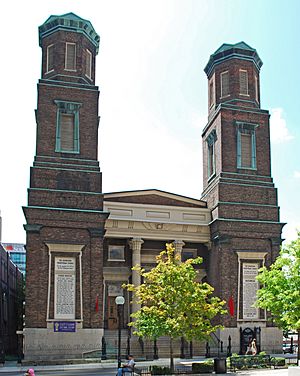Downtown Presbyterian Church (Nashville) facts for kids
Quick facts for kids Downtown Presbyterian Church |
|
|---|---|

2010
|
|
| 36°09′47″N 86°46′47″W / 36.1630°N 86.7798°W | |
| Location | 154 5th Ave North Nashville, Tennessee |
| Country | USA |
| Denomination | Presbyterian Church (U.S.A.) |
| History | |
| Former name(s) | First Presbysterian Church |
| Status | Church |
| Architecture | |
| Functional status | Active |
| Heritage designation | NRHP |
| Designated | July 8, 1970 |
| Architect(s) | William Strickland |
| Style | Egyptian Revival |
| Completed | 1846 |
| Specifications | |
| Number of towers | 2 |
| Administration | |
| Presbytery | Middle Tennessee |
| Synod | Living Waters |
The Downtown Presbyterian Church is a historic building in Nashville, Tennessee. It is part of the Presbyterian Church (USA). This church was once known as the First Presbyterian Church. You can find it at the corner of Rep. John Lewis Way and Church Street. Because of its unique Egyptian Revival architecture, it was named a National Historic Landmark in 1993.
Contents
History of the Church Building
The church congregation started meeting at this spot in 1816. Their first building burned down in 1832. A second church was built in the same year. However, another fire in 1848 destroyed that building too. The church you see today was built after this second fire. The church changed its name to "Downtown" in 1955. This happened when the "First Presbyterian" congregation moved out of downtown Nashville.
Who Designed the Church?
The current church building was designed by William Strickland. He was a famous architect. Strickland also designed the Tennessee State Capitol building. He chose a special style called Egyptian Revival. This style became popular when people learned more about Ancient Egypt.
Egyptian Style Details
The outside of the church has Egyptian-style lotus columns. It also features a winged sun disk, which is an ancient Egyptian symbol. Inside, you can see stained glass windows and woodwork. There are even pictures of Egyptian scenes on the walls. Strickland's design was inspired by new discoveries from Egypt. The church's two towers look like those on St. Stephen's Church in Philadelphia. Strickland lived in Philadelphia before moving to Nashville.
A Rare Architectural Style
The Downtown Presbyterian Church is one of the few buildings in the United States built in the Egyptian Revival style. It might be the best church example still standing. William Strickland also designed another building with Egyptian elements in Philadelphia in 1825. But that building is no longer there. Two other churches in the U.S. with Egyptian themes are still around. These are the First Baptist Church of Essex, Connecticut, and the First Presbyterian Church (Sag Harbor) in New York. You can take a virtual tour of the Downtown Presbyterian Church on its website.
Famous Connections
Many important people and events are linked to this church.
Presidents and Governors
When it was called First Presbyterian Church, President Andrew Jackson was a member. He was given a special sword on the steps of the original church. This happened after the Battle of New Orleans. Later, Tennessee Governor James K. Polk was sworn into office in the second church building.
A Hospital During the Civil War
During the American Civil War, the church building was taken over by Federal forces. It was used as a military hospital. It became Nashville's Union Hospital No. 8. It had 206 beds for soldiers.
Helping the Community
The church has always been a place of help for Nashville's citizens. It offered refuge during floods in the 1920s. Soldiers used it during World War II. Today, the church continues to help people in need.
Images for kids
See also
- List of National Historic Landmarks in Tennessee
- National Register of Historic Places listings in Davidson County, Tennessee
- Egyptian Revival architecture



